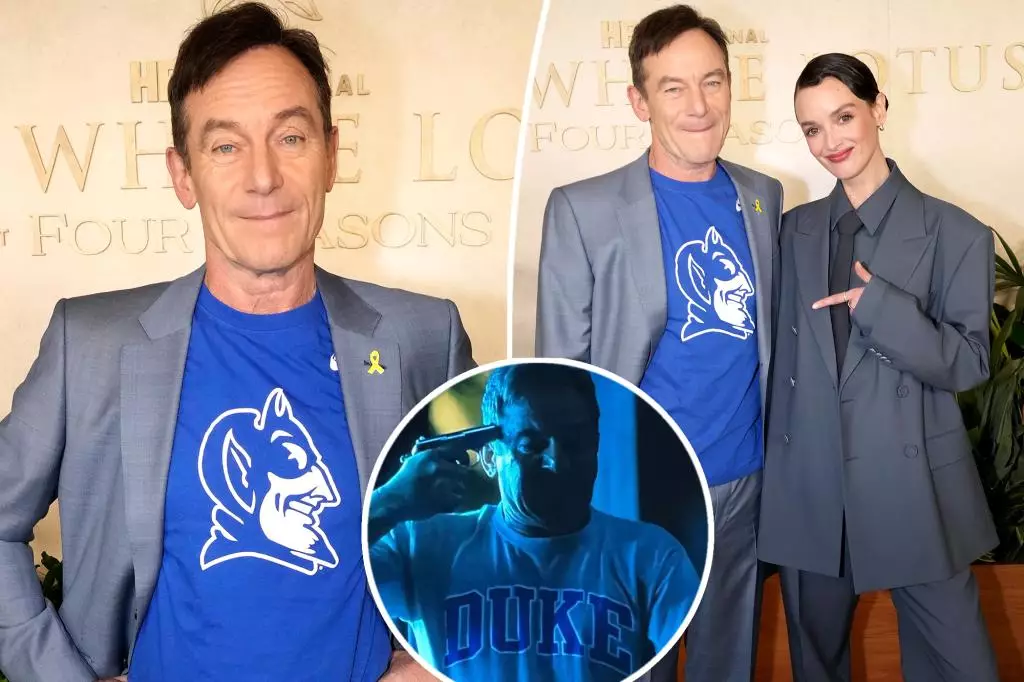The recent finale of HBO’s “The White Lotus” served as a remarkable moment not just for fans of the show but also for actor Jason Isaacs, who unapologetically donned a blue Duke University T-shirt under his tailored gray suit. The choice was deliberate and rousing, a bold assertion of his character Timothy Ratliff’s identity amid rising tensions with the prestigious university. Attending this star-studded event at the Four Seasons Hotel in Westlake Village, Isaacs’ fashion statement raised eyebrows, offering a glimpse into the intersection between entertainment and institutional sensibilities.
The Controversy with Duke University
Duke’s institution responded to its unauthorized logo’s use in “The White Lotus,” labeling the imagery as “troubling” and inconsistent with its values. The specific scene featuring a character in distress, wearing the Duke T-shirt, unleashed a flurry of backlash that depicted the university in a less-than-flattering light. Frank Tramble, the university’s vice president of communications, articulated the sentiment that this representation led to confusion over the institution’s endorsement. Yet, while Duke’s concerns are valid in maintaining its brand integrity, one must question the fundamental essence of artistic expression. Is it not the responsibility of creators to push boundaries and provoke thought, no matter how uncomfortable?
Fashion Statements and Symbolism
Isaacs isn’t just a participant in this complex narrative; his wardrobe choices become an emblem of defiance against institutional authority and a commentary on the often contentious relationship between art and academia. In a time where art can evoke strong societal dialogues, fashion at such events often extends beyond mere aesthetics; they are battlegrounds for identity and intention. Isaacs’ T-shirt not only represents his character’s misadventures but also symbolizes the artistic freedom that must coexist with organizational parameters.
A Collective Act of rebellion
Other cast members, such as Patrick Schwarzenegger and Charlotte Le Bon, also embraced the spirit of their characters with noteworthy outfits. Schwarzenegger’s classic white pinstripe suit harkens to the luxurious vibe of vacationing elites, integral to the series’ overarching critique of class structures. Le Bon’s decision to don a Gucci suit and tie challenges conventional gender norms on display, asserting that fashion can serve as both a personal and political statement.
The Power of Memes and Modern Culture
A striking aspect of this controversy is the evolution of the meme culture surrounding “The White Lotus.” Following a viral incident during March Madness, the discourse surrounding Isaacs’ character has entrenched itself deeply in social media. The juxtaposition between humor and tragedy in modern storytelling deserves recognition, and users of platforms like Twitter or Instagram have turned Matthew Ratliff’s predicaments into meme fodder, demonstrating that a story’s impact can transcend traditional fan engagement.
This blend of high-stakes drama, social commentary, and playful aesthetics underscores a significant moment in television history, revealing how creativity can catalyze conversations that resonate far beyond screens. Jason Isaacs thereby emerges not merely as an actor but as a symbol of a cultural dialogue, reminding us that the realms of art, representation, and expression are often intertwined in unexpected ways.


Leave a Reply